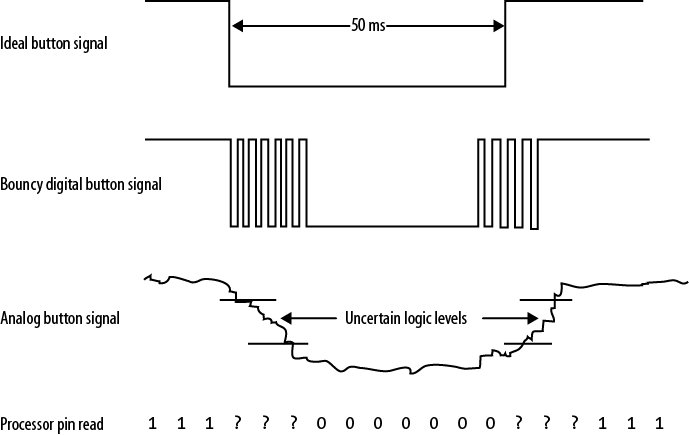

If (humidity = 998) //Humidty sensor failed to respond Serial.println("Weather Shield online!") ĭigitalWrite(STAT_BLUE, HIGH) //Blink stat LED MyPressure.enableEventFlags() // Enable all three pressure and temp event flags tOversampleRate(7) // Set Oversample to the recommended 128 tModeBarometer() // Measure pressure in Pascals from 20 to 110 kPa PinMode(STAT_GREEN, OUTPUT) //Status LED Green PinMode(STAT_BLUE, OUTPUT) //Status LED Blue Serial.println("Weather Shield Example") Long lastSecond //The millis counter to see when a second rolls by Weather myHumidity //Create an instance of the humidity sensor MP元115A2 myPressure //Create an instance of the pressure sensor
Bounce.h arduino install#
#include "SparkFun_Si7021_Breakout_Library.h" //Humidity sensor - Search "SparkFun Si7021" and install from Library Manager #include "SparkFunMP元115A2.h" //Pressure sensor - Search "SparkFun MP元115" and install from Library Manager
Bounce.h arduino code#
Removed HTU21D code and replaced with Si7021 Be sure to checkout the other more advanced examples for creating This example prints the current humidity, air pressure, temperature and light levels. License: This code is public domain but you buy me a beer if you use this and we meet someday (Beerware license).

Or copy and paste the code below into the Arduino IDE: language:c Lcd.Open the Weather_Shield_Basic.ino sketch. #define max_distance 30 // Maximum distance we want to ping for (in centimeters). LcdBarGraphI2C lbg(&lcd, 16, 0, 1) // Creates an LCD Bargraph object. You can watch the video tutorial below to learn how you can create your own library. In the code below I have used a custom library called LcdBarGraph.h. In this case you need to create your own library that supports this display. The major challenge with this setup is that we are using an I2C display but most Arduino LCD Bar Graph libraries do not support this type of display.

We can now be able to display distance on LCD using a bar graph as shown in the picture below. Lcd.setCursor(0,2) //set cursor at column 0 row 2ĭisplaying Distance from HC-SR04 Ultrasonic sensor on LCD as a Bar Graph. Lcd.setCursor(0,0) //set cursor at column 0 row 1 Int sound=500 // variable for buzzer sound The code below involves triggering the ultrasonic sensor and measuring the received signal pulse width manually, #include Since it operates on 5 volts, it can be hooked directly to an Arduino or any other 5V logic microcontrollers.Ĭode for measuring distance using HC-SR04 Ultrasonic sensor and Arduino. The sensor is small, easy to use in any robotics project and offers excellent non-contact range detection between 2 cm to 400 cm with an accuracy of 3mm. If it receives them it produces an output pulse whose width can be used to determine the distance the pulse travelled. The receiver listens for the transmitted pulses. The one acts as a transmitter which converts electrical signal into 40 KHz ultrasonic sound pulses. The HC-SR04 Ultrasonic distance sensor consists of two ultrasonic transducers. However, ultrasound has a frequency of over 40,000 Hz and is therefore inaudible to humans. Human ears can hear sound waves that vibrate in the range from about 20Hz to about 20,000Hz times a second. Ultrasound is high-pitched sound waves with frequencies higher than the audible limit of human hearing. In this tutorial this sensor is connected to Arduino to achieve this function. The HC-SR04 Ultrasonic sensor can be used to detect objects in a range of up to 13 feet away.


 0 kommentar(er)
0 kommentar(er)
